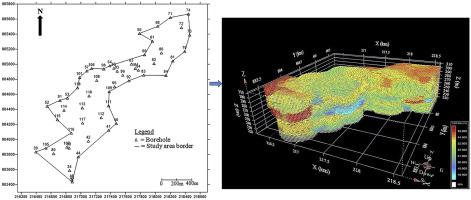Geoscience Frontiers ( IF 8.5 ) Pub Date : 2020-04-08 , DOI: 10.1016/j.gsf.2020.02.019 Thomas Busuyi Afeni , Victor Oluwatosin Akeju , Adeyemi Emman Aladejare

|
Mining projects especially relating to limestone deposits require an accurate knowledge of tonnage and grade, for both short and long-term planning. This is often difficult to establish as detailed exploration operations, which are required to get the accurate description of the deposit, are costly and time consuming. Geologists and mining engineers usually make use of geometric and geostatistical techniques, for estimating the tonnage and grade of ore reserves. However, explicit assessments into the differences between these techniques have not been reported in literature. To bridge this research gap, a comparative study is carried out to compare the qualitative estimated reserve of Oyo-Iwa limestone deposit located in Nigeria, using geometric and geostatistical methods. The geometric method computes the reserve of the limestone deposit as 74,536,820 t (mean calcite, CaO grade = 52.15) and 99,674,793 t (mean calcite, CaO grade = 52.32), for the northern and southern zones of the deposit, respectively. On the other hand, the geostatistical method calculates the reserve as 81,626,729.65 t (mean calcite, CaO grade = 53.36) and 100,098,697.46 t (mean calcite, CaO grade = 52.96), for the two zones, respectively. The small relative difference in tonnage estimation between the two methods (i.e., 9.51% and 0.43%), proves that the geometric method is effective for tonnage estimation. In contrast, the relative difference in grade estimation between the two methods (i.e., 2.32% and 1.26%) is not negligible, and could be crucial in maintaining the profitability of the project. The geostatistical method is, therefore, more suitable, reliable and preferable for grade estimation, since it involves the use of spatial modelling and cross-validated interpolation. In addition, the geostatistical method is used to produce quality maps and three-dimensional (3-D) perspective view of the limestone deposit. The quality maps and 3-D view of the limestone deposit reveal the variability of the limestone grade within the deposit, and it is useful for operational management of the limestone raw materials. The qualitative mapping of the limestone deposit is key to effective production scheduling and accurate projection of raw materials for cement production.
中文翻译:

几何和地统计学方法对石灰岩矿床定性储量估算的比较研究
对于短期和长期计划,特别是与石灰石矿床有关的采矿项目都需要准确的吨位和品位知识。由于要获得矿床的准确描述所需要的详细的勘探作业既昂贵又费时,因此通常难以建立。地质学家和采矿工程师通常利用几何和地统计学技术来估算矿石储量的吨位和品位。但是,文献中尚未报道对这些技术之间差异的明确评估。为了弥合这一研究差距,我们进行了一项比较研究,以几何和地统计学方法比较了位于尼日利亚的Oyo-Iwa石灰岩矿床的定性估计储量。几何方法计算出石灰岩矿床的储量为74,536,矿床北部和南部分别为820吨(方解石,CaO品位= 52.15)和99,674,793吨(方解石,CaO品位= 52.32)。另一方面,地统计学方法计算出两个区域的储量分别为81,626,729.65 t(平均方解石,CaO品位= 53.36)和100,098,697.46 t(平均方解石,CaO品位= 52.96)。两种方法之间吨位估计的相对较小差异(即9.51%和0.43%),证明了几何方法对于吨位估计是有效的。相比之下,两种方法之间的等级估计相对差异(即2.32%和1.26%)是不可忽略的,并且对于保持项目的盈利能力可能至关重要。因此,地统计方法对于坡度估算而言更合适,更可靠且更可取,因为它涉及空间建模和交叉验证插值的使用。此外,地统计学方法用于生成石灰石矿床的质量图和三维(3-D)透视图。石灰岩矿床的质量图和3-D视图揭示了该矿床内石灰岩品位的变化性,对于石灰石原料的运营管理很有用。石灰石矿床的定性绘图对于有效的生产计划和水泥生产原料的准确投影至关重要。石灰岩矿床的质量图和3-D视图揭示了该矿床内石灰岩品位的变化性,对于石灰石原料的运营管理很有用。石灰石矿床的定性绘图对于有效的生产计划和水泥生产原料的准确投影至关重要。石灰岩矿床的质量图和3-D视图揭示了该矿床内石灰岩品位的变化性,对于石灰石原料的运营管理很有用。石灰石矿床的定性绘图对于有效的生产计划和水泥生产原料的准确投影至关重要。











































 京公网安备 11010802027423号
京公网安备 11010802027423号